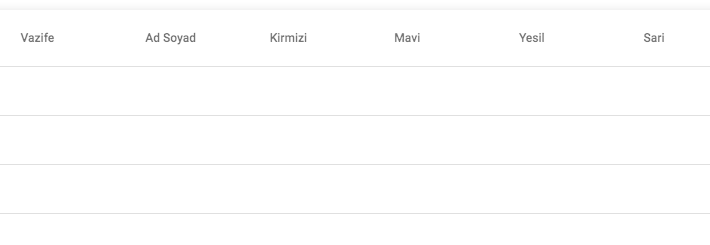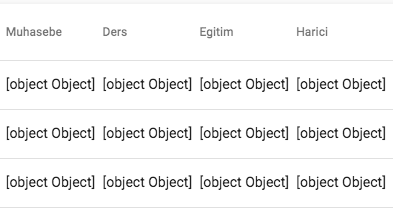I need to use angular material table without model, because I don't know what will come from service.
So I am initializing my MatTableDataSource and displayedColumns dynamically in component like that :
TableComponent :
ngOnInit() {
this.vzfPuanTablo = [] //TABLE DATASOURCE
//GET SOMETHING FROM SERVICE
this.listecidenKisi = this.listeciServis.listecidenKisi;
this.listecidenVazife = this.listeciServis.listecidenVazife;
//FILL TABLE DATASOURCE
var obj = {};
for (let i in this.listecidenKisi ){
for( let v of this.listecidenVazife[i].vazifeSonuclar){
obj[v.name] = v.value;
}
this.vzfPuanTablo.push(obj);
obj={};
}
//CREATE DISPLAYED COLUMNS DYNAMICALLY
this.displayedColumns = [];
for( let v in this.vzfPuanTablo[0]){
this.displayedColumns.push(v);
}
//INITIALIZE MatTableDataSource
this.dataSource = new MatTableDataSource(this.vzfPuanTablo);
}
The most important part of code is here :
for( let v in this.vzfPuanTablo[0]) { this.displayedColumns.push(v); }
I am creating displayedColumns here dynamically, it means; even I don't know what will come from service, I can show it in table.
For example displayedColumns can be like that:
- ["one", "two" , "three" , "four" , "five" ]
or
- ["stack","overflow","help","me]
But it is not problem because I can handle it.
But when I want to show it in HTML, I can't show properly because of
matCellDef thing:
TableHtml :
<mat-table #table [dataSource]="dataSource" class="mat-elevation-z8">
<ng-container *ngFor="let disCol of displayedColumns; let colIndex = index" matColumnDef="{{disCol}}">
<mat-header-cell *matHeaderCellDef>{{disCol}}</mat-header-cell>
<mat-cell *matCellDef="let element "> {{element.disCol}}
</mat-cell>
</ng-container>
<mat-header-row *matHeaderRowDef="displayedColumns"></mat-header-row>
<mat-row *matRowDef="let row; columns: displayedColumns;"></mat-row>
</mat-table>
My problem is here:
<mat-cell *matCellDef="let element "> {{element.disCol}} < / mat-cell>
In fact, I want to display element."disCol's value" in the cell, but I don't know how can I do that.
Otherwise, everything is ok except this element."disCol's value" thing.
When I use {{element.disCol}} to display value of element that has disCols's value , all cells are empty like that:
Other example that using {{element}} only:
Also as you can see:
Table datasource is changing dynamically. It means I can't use
{{element.ColumnName}}easily, because I don't know even what is it.- First Example's displayedColumns = ['Vazife', 'AdSoyad', 'Kirmizi', 'Mavi', 'Yesil', 'Sari'];
- Second Example's displayedColumns = ['Muhasebe', 'Ders', 'Egitim', 'Harici'];
matHeaderCellDefis correct , because it is using {{disCol}} directly.
But I need to read disCol's value, and display element.(disCol's value) in the cell.
How can I do that ?


